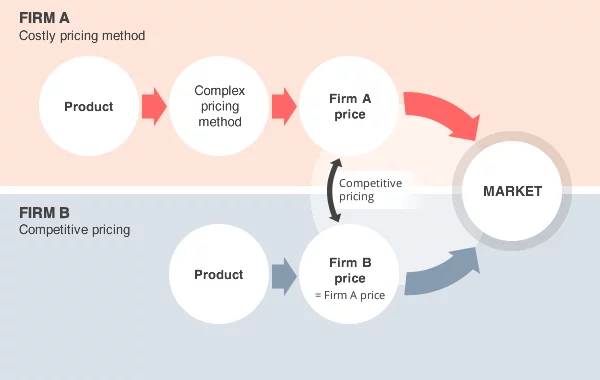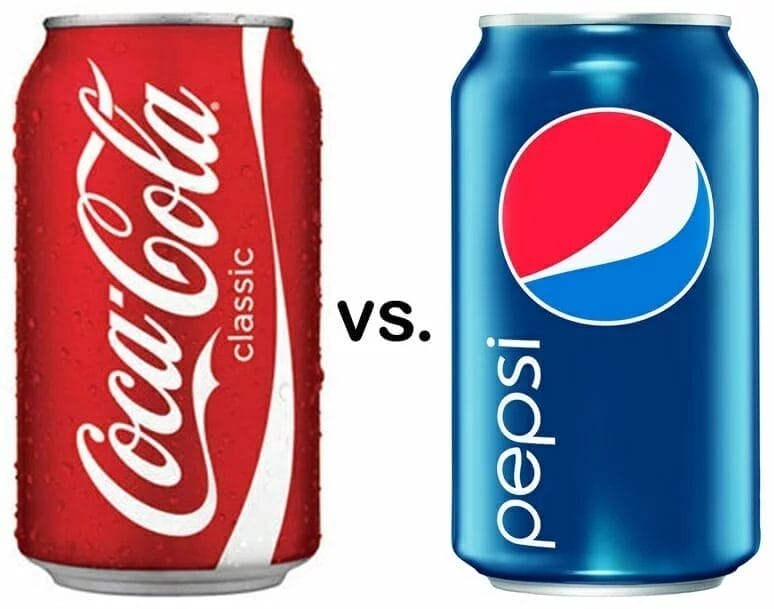In today’s fiercely competitive marketplace, pricing strategies have become a critical component in driving business success. One particularly effective approach is competition-based pricing, where prices are set based on the rates offered by competitors.
This strategy allows companies to position themselves strategically within the market and leverage their competitive advantages. However, like any strategy, competition-based pricing has its own set of pros and cons that must be carefully evaluated.

In this article, we delve into the intricacies of competition-based pricing, examining its benefits and drawbacks. Real-world examples and key considerations for implementation are provided, ensuring that businesses across various industries, from retail to technology, can master the art of pricing and unleash the power of competition-based strategies to drive profitability and stay ahead of the competition.
Key Takeaways
- Competition-based pricing uses competitor prices as benchmarks and can be a simple and dynamic pricing strategy.
- It is important to consider the advantages and disadvantages of competition-based pricing before implementing it and to continuously assess and adjust the pricing strategy based on customer demand and profitability.
- Captive product pricing can be used to increase sales of a main product and generate revenue from related products, but it may also risk losing customers to competitors.
- Value-based pricing focuses on the perceived value of a product or service to customers and can maximize profits, but it requires careful consideration of customer segmentation, market research, and product differentiation.
Benefits of Competition-Based Pricing
Competition-Based Pricing offers several advantages for businesses looking to optimize their pricing strategies. One of the key benefits is its flexibility, making it suitable for various industries, including small retailers and the hospitality industry.
For small retailers with limited funds, competition-based pricing allows them to stay competitive by offering prices that are either below or on par with their competitors. This strategy can help attract price-sensitive customers and increase market share.
In the hospitality industry, competition-based pricing is crucial for maximizing occupancy rates. By monitoring competitor prices and adjusting their own rates accordingly, hotels and resorts can ensure they remain competitive in the market.
Additionally, competition-based pricing provides businesses with valuable insights into market trends and helps them stay informed about pricing strategies adopted by market leaders.
Advantages and Disadvantages of Competition-Based Pricing
Competition-based pricing is a strategy that offers businesses certain advantages, but it also comes with its fair share of disadvantages.
One of the advantages is that prices are dynamic and can change as the business grows. This allows businesses to stay competitive in the market and respond to changes in customer demand and competitor pricing.
Additionally, competition-based pricing is simple to execute without complicated formulas or calculations. It can also be combined with other pricing strategies to consider consumer demand and production costs.
However, there are also disadvantages to competition-based pricing. One major disadvantage is that it ignores consumer demand, which can lead to a loss of touch with the market. Businesses that solely rely on competition-based pricing risk becoming complacent and may overlook other signs that indicate pricing adjustments are needed.

Furthermore, pricing too low can hurt profit margins, while pricing too high may not be sustainable. Lastly, market saturation with competition-based pricing can lead to price fluctuations, making it difficult for businesses to maintain consistent pricing.
In evaluating the effectiveness of competition-based pricing, businesses should consider the impact on customer loyalty. While competition-based pricing may attract customers initially, it may not foster long-term loyalty if customers perceive the pricing strategy as solely focused on undercutting competitors.
Therefore, it is crucial for businesses to carefully assess the advantages and disadvantages of competition-based pricing and to continuously monitor customer feedback and market trends to make informed pricing decisions.
Examples of Competition-Based Pricing
Moving forward into the topic of competition-based pricing, let’s explore some real-world examples of how businesses have successfully utilized this strategy.
In the retail industry, companies like Walmart and Best Buy offer price-match guarantees to attract customers and stay competitive. They adjust their prices to match or beat their competitors, ensuring that customers perceive them as offering the best value.
On the other hand, in the hospitality industry, competition-based pricing is used to maximize occupancy rates. Hotels and resorts often adjust their prices based on the rates offered by their competitors in order to attract customers. This strategy allows them to stay competitive and maintain high occupancy levels.
In contrast, value-based pricing focuses on the perceived value of a product or service to customers, rather than competitor prices.
Walmart, Target, Best Buy
A titan in the retail sector, Walmart stands out for its aggressive competitive pricing strategy. This global retail giant continuously scans the prices of competitors like Target, Costco, and Amazon, especially for essential goods like electronics, toys, groceries, and household items. Walmart’s goal is to always offer lower or matching prices to attract cost-conscious consumers, thereby maintaining its reputation as a budget-friendly shopping destination. They compete with stores such as Target and Bestbuy and try to match prices as much as possible. So much so that Best Buy even offers a price match policy against other electronic retailers.
Freshco, Safeway and other grocery chains
Grocery chains are famous for adding a “price match” policy which means they will match their competitor’s pricing and give additional discounts. This is a prime example of competition-based pricing because they try to match their competition to begin with and if they can’t or miss some, they offer price matching so they can still stay competitive in the prices.
Southwest Airlines & Others in the Industry
In the airline industry, Southwest Airlines is renowned for its dynamic pricing model, which is heavily influenced by the fares offered by competitors such as Delta, United Airlines, and American Airlines. Southwest’s strategy focuses on offering competitive, often lower, prices to capture a broader customer base, including both leisure and business travelers. They also emphasize no-fee policies and other value-added services to differentiate themselves while maintaining competitive fares.
Coca-Cola and Pepsi
The rivalry between Coca-Cola and Pepsi is a classic example of competitive pricing in the beverage industry. Both companies closely monitor each other’s pricing strategies, promotional activities, and marketing campaigns.

Adjustments in prices, whether for individual cans/bottles or bulk packaging, are often made in response to changes implemented by the other. This rivalry extends beyond pricing into product innovation, advertising, and global market penetration, but competitive pricing remains a key element in their ongoing battle for market dominance.
Key Considerations for Competition-Based Pricing
When implementing competition-based pricing, there are several key considerations that businesses should keep in mind.
One important consideration is evaluating competitor pricing. It is crucial to thoroughly analyze the prices set by competitors in order to determine the appropriate pricing strategy. This evaluation should include not only the current prices but also any pricing patterns or trends that may emerge.
Another consideration is implementing dynamic pricing. Competition-based pricing requires the ability to adjust prices in response to changes in the market and competitor actions. This means businesses must have the systems and processes in place to monitor competitor prices regularly and make pricing adjustments accordingly.
Understanding Captive Product Pricing
In the realm of pricing strategies, an important tactic to consider is captive product pricing. This strategy involves setting a lower cost for one product while pricing related products at a higher rate. The goal is to increase sales of the main product while generating revenue from the higher-priced related products.
However, captive product pricing also presents challenges. Customers may feel trapped and switch to competitors if they perceive the pricing as unfair or if they find alternative options. To mitigate these challenges, businesses must carefully consider factors such as customer loyalty and the pricing strategies employed by competitors.
On the other hand, value-based pricing offers benefits such as maximizing profits by capturing the perceived value customers are willing to pay. This strategy involves setting prices based on the value that customers attach to a product or service. By understanding the perceived value and willingness to pay, businesses can set prices that align with customer expectations and maximize profits.
The Power of Value-Based Pricing
Value-based pricing is a strategic approach that maximizes profits by capturing the perceived value customers are willing to pay for a product or service. This pricing strategy focuses on understanding the customer’s perception of value and aligning the price accordingly.
In the service industry, value-based pricing is particularly relevant as it allows businesses to reflect the expertise and quality of their services. By understanding the unique value proposition they offer, businesses can set prices that not only cover costs but also generate higher profits.
On the other hand, competition-based pricing is commonly used in the hospitality industry to attract customers and maximize occupancy rates. This strategy involves setting prices based on the prices of competitors in the market.
Value-based pricing, however, allows businesses to differentiate themselves based on the value they provide rather than simply matching or undercutting competitor prices.
Exploring Sticky Prices
Sticky prices are a pricing strategy where prices remain unchanged despite changes in costs or market conditions. This strategy is often employed by businesses seeking to maintain stability and reduce price volatility in the market. By keeping prices constant, businesses aim to establish a sense of reliability and consistency for their customers.
However, implementing sticky prices can present challenges, such as potential loss of market share to competitors who adjust prices. To better understand the concept of sticky prices, the following table provides a comparison between sticky prices and flexible prices:
| Sticky Prices | Flexible Prices |
|---|---|
| Prices remain unchanged despite changes in costs or market conditions | Prices are adjusted based on changes in costs or market conditions |
| Aim to provide stability and reliability for customers | Allow for responsiveness to market dynamics |
| May lead to customer loyalty due to consistent pricing | May attract price-sensitive customers through competitive pricing |
Pricing Strategies in the Retail Industry
One common pricing strategy utilized in the retail industry is competition-based pricing. This strategy involves setting prices based on competitor prices rather than customer demand or production costs. It is also known as competitor-based pricing or a competitive pricing strategy.
Retailers often use this strategy when they sell similar products to their competitors. To implement competition-based pricing effectively, retailers need to conduct thorough market research and customer segmentation to understand their competitors and target market. By analyzing competitor prices and market trends, retailers can determine whether to price below, match, or even price above competitor prices.
However, it is important to consider the advantages and disadvantages of this strategy, as it may lead to a loss of touch with the market and potential complacency. Therefore, continuous monitoring and adjustment of pricing strategy based on customer demand and profitability are essential in the retail industry.
Pricing Strategies in the Technology Industry
A popular pricing strategy employed in the technology industry is competition-based pricing. This strategy involves setting prices based on competitor prices rather than customer demand or production costs. It is also known as competitor-based pricing or a competitive pricing strategy.
In the technology industry, where innovation is key, businesses often adopt innovative pricing approaches to stay competitive. These approaches may include dynamic pricing, where prices can change as the business grows, or value-based pricing, which is based on the perceived value of a product or service to customers.
Pricing Strategies in Different Industries
Pricing strategies in different industries vary based on customer demand, competition, and the nature of the products or services being offered. In the retail industry, a mix of pricing strategies is used to cater to customer demand and stay competitive. The technology industry often adopts value-based pricing due to the rapid innovation of products.
The service industry relies on value-based pricing to reflect the expertise and quality of services offered. The pharmaceutical industry often employs captive product pricing to generate revenue from related products. Lastly, the hospitality industry utilizes competition-based pricing to attract customers and maximize occupancy rates. Below is a table summarizing the pricing strategies in different industries:
| Industry | Pricing Strategy |
|---|---|
| Retail | Mix of pricing strategies |
| Technology | Value-based pricing |
| Service | Value-based pricing |
| Pharmaceutical | Captive product pricing |
| Hospitality | Competition-based pricing |
Conclusion
Competition-based pricing is a strategic approach that can greatly impact a company’s success in the business world. By setting prices based on market rates of competitors, businesses can effectively position themselves and capitalize on their competitive advantage. While this pricing strategy has its advantages and disadvantages, it remains a powerful tool for driving profitability and staying ahead of the competition.
As businesses continue to navigate the competitive landscape, mastering the art of competition-based pricing will be crucial in achieving long-term success and maintaining a strong market position.
One interesting statistic to consider is that according to a study by Harvard Business Review, companies that implement competition-based pricing strategies experience an average increase in profitability of 2-5%. This statistic highlights the significant impact that pricing strategies can have on a company’s bottom line and underscores the importance of carefully considering and implementing competition-based pricing tactics.







